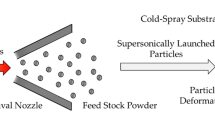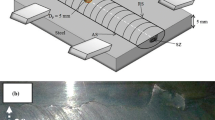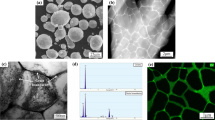Abstract
In an effort to improve the fretting corrosion resistance of cold spray (CS) additively manufactured 316L stainless steel (SS), friction stir processing (FSP) was applied as a post-processing surface modification technique. The change in wear-corrosion synergy and degradation was evaluated by assessing changes in mechanical, chemical, and elemental responses. It was found that the improvement in hardness and reduction in porosity induced by FSP improved the stiffness of the surface, resulting in a nearly full-stick fretting regime. Due to the influence of fretting corrosion, high amounts of Ni were present within the fretting wear track, decreasing the surface’s propensity for accelerated corrosion. The fretting wear mechanism for the CS FSP specimen was abrasion-dominant, whereas the CS specimen mainly consisted of surface fracturing and some abrasion. Other material factors such as surface strengthening, microstructural refinement, and changes in the atomic phase enabled by FSP also contributed to the improvement in fretting corrosion resistance. Collectively, this work shows that FSP post-treatment is a viable technique to improve the fretting corrosion degradation resistance of additively manufactured CS 316L SS components.





















Similar content being viewed by others
References
Chen J, Mraied H, Cai W (2018) Determining tribocorrosion rate and wear-corrosion synergy of bulk and thin film aluminum alloys. J Vis Exp 139:58235. https://doi.org/10.3791/58235
Cao Y et al (2023) Revealing the critical failure factor and sub-surface damage mechanism of 316 stainless steel during fretting corrosion under the molten lead-bismuth eutectic. Tribol Int 187:108767. https://doi.org/10.1016/j.triboint.2023.108767
Liu X-C et al (2019) Effects of temperature on fretting corrosion between alloy 690TT and 405 stainless steel in pure water. Acta Metall Sin (Engl Lett) 32(12):1437–1448. https://doi.org/10.1007/s40195-019-00929-9
Zhang Y, Ming H, Tang L, Wang J, Qian H, Han E-H (2021) Effect of the frequency on fretting corrosion behavior between alloy 690TT tube and 405 stainless steel plate in high temperature pressurized water. Tribology International 164:107229. https://doi.org/10.1016/j.triboint.2021.107229
“Forms of corrosion – corrosion.” Accessed: Sep. 18, 2023. https://public.ksc.nasa.gov/corrosion/forms-of-corrosion/
X. Ma, S. Zhang, W. Tan, and G. Zhu, “Fretting corrosion behavior of 316L stainless steel heat exchanger tube in NaCl solution,” presented at the ASME 2022 Pressure Vessels & Piping Conference, American Society of Mechanical Engineers Digital Collection, Nov. 2022. doi: https://doi.org/10.1115/PVP2022-84442.
Lgried M, Liskiewicz T, Neville A (2012) Electrochemical investigation of corrosion and wear interactions under fretting conditions. Wear 282–283:52–58. https://doi.org/10.1016/j.wear.2012.02.001
Mischler S (2008) Triboelectrochemical techniques and interpretation methods in tribocorrosion: a comparative evaluation. Tribol Int 41(7):573–583. https://doi.org/10.1016/j.triboint.2007.11.003
Maher M, Iraola-Arregui I, Ben Youcef H, Rhouta B, Trabadelo V (2022) The synergistic effect of wear-corrosion in stainless steels: a review. Materials Today: Proceedings 51:1975–1990. https://doi.org/10.1016/j.matpr.2021.05.010
“Standard guide for determining synergism between wear and corrosion.” Accessed: Jun. 28, 2022. https://www.astm.org/g0119-09r21.html
An S, Joshi B, Yarin AL, Swihart MT, Yoon SS (2020) Supersonic cold spraying for energy and environmental applications: one-step scalable coating technology for advanced micro- and nanotextured materials. Adv Mater 32(2):e1905028. https://doi.org/10.1002/adma.201905028
Smith MF (2007) 3 - comparing cold spray with thermal spray coating technologies. In: Champagne VK (ed) The cold spray materials deposition process, Woodhead Publishing Series in Metals and Surface Engineering. Woodhead Publishing, pp 43–61. https://doi.org/10.1533/9781845693787.1.43
Li Y-J, Luo X-T, Li C-J (2021) Improving deposition efficiency and inter-particle bonding of cold sprayed Cu through removing the surficial oxide scale of the feedstock powder. Surf Coat Technol 407:126709. https://doi.org/10.1016/j.surfcoat.2020.126709
Zhizhong W, Chao H, Huang G, Bin H, Bin H (2021) Cold spray micro-defects and post-treatment technologies: a review. Rapid Prototyping Journal. https://doi.org/10.1108/RPJ-12-2020-0302
Ralls AM, Menezes PL (2023) Understanding the tribo-corrosion mechanisms of friction stir processed steel deposited by high-pressure deposition additive manufacturing process. Int J Adv Manuf Technol. https://doi.org/10.1007/s00170-023-11918-9
Daroonparvar M et al (2023) Pitting corrosion behavior and corrosion protection performance of cold sprayed double layered noble barrier coating on magnesium-based alloy in chloride containing solutions. Journal of Magnesium and Alloys. https://doi.org/10.1016/j.jma.2023.09.008
S. M. Hassani-Gangaraj, A. Moridi, and M. Guagliano, “Critical review of corrosion protection by cold spray coatings,” Surf Eng, vol. 31, no. 11, pp. 803–815, Nov. 2015, doi: https://doi.org/10.1179/1743294415Y.0000000018.
Ralls AM, Kasar AK, Menezes PL (2021) Friction stir processing on the tribological, corrosion, and erosion properties of steel: a review. J Manuf Mater Process 5(3). https://doi.org/10.3390/jmmp5030097
“Metallographic etchants for stainless steels.” Accessed: Aug. 06, 2020. https://www.metallographic.com/Metallographic-Etchants/Metallography-Stainless-steel-etchants.htm
Wei Y-K, Li Y-J, Zhang Y, Luo X-T, Li C-J (2018) Corrosion resistant nickel coating with strong adhesion on AZ31B magnesium alloy prepared by an in-situ shot-peening-assisted cold spray. Corros Sci 138:105–115. https://doi.org/10.1016/j.corsci.2018.04.018
McCafferty E (2005) Validation of corrosion rates measured by the Tafel extrapolation method. Corros Sci 47(12):3202–3215. https://doi.org/10.1016/j.corsci.2005.05.046
Jin W, Wu G, Feng H, Wang W, Zhang X, Chu PK (2015) Improvement of corrosion resistance and biocompatibility of rare-earth WE43 magnesium alloy by neodymium self-ion implantation. Corros Sci 94:142–155. https://doi.org/10.1016/j.corsci.2015.01.049
Zhang C et al (2019) Influence of surface pretreatment on phosphate conversion coating on AZ91 Mg alloy. Surf Coat Technol 359:414–425. https://doi.org/10.1016/j.surfcoat.2018.12.091
Cui X, Lin X, Liu C, Yang R, Zheng X, Gong M (2015) Fabrication and corrosion resistance of a hydrophobic micro-arc oxidation coating on AZ31 Mg alloy. Corros Sci 90:402–412. https://doi.org/10.1016/j.corsci.2014.10.041
“Electrochemical corrosion measurements-galvanic corrosion Gamry instruments.” Accessed: Sep. 28, 2023. https://www.gamry.com/application-notes/corrosion-coatings/basics-of-electrochemical-corrosion-measurements/
“ImageJ.” Accessed: Aug. 18, 2023 https://imagej.net/ij/index.html
Brewer LN, Schiel JF, Menon ESK, Woo DJ (2018) The connections between powder variability and coating microstructures for cold spray deposition of austenitic stainless steel. Surf Coat Technol 334:50–60. https://doi.org/10.1016/j.surfcoat.2017.10.082
Williamson GK, Hall WH (1953) X-ray line broadening from filed aluminium and wolfram. Acta Metall 1(1):22–31. https://doi.org/10.1016/0001-6160(53)90006-6
Sun W et al (2020) Post-process treatments on supersonic cold sprayed coatings: a review. Coatings 10(2). https://doi.org/10.3390/coatings10020123
S. Speakman, “Estimating crystallite size using XRD.” chrome-extension://efaidnbmnnnibpcajpcglclefindmkaj/http://prism.mit.edu/XRAY/oldsite/CrystalSizeAnalysis.pdf
Suciu CV, Uchida T (2010) Modeling and simulation of the fretting hysteresis loop. In: 2010 International Conference on P2P, Parallel, Grid, Cloud and Internet Computing, pp 560–564. https://doi.org/10.1109/3PGCIC.2010.96
Sahu A, Kamaraj M, Kesavan D (2023) Experimental investigation on fretting wear behavior of additively manufactured Inconel 718. J of Materi Eng and Perform. https://doi.org/10.1007/s11665-023-08518-9
Gates RS, Hsu M, Klaus EE (1989) Tribochemical mechanism of alumina with water. Tribology Transactions 32(3):357–363. https://doi.org/10.1080/10402008908981900
Wang Y, Yang Y, Zhao Y, Tian W, Bian H, He J (2009) Sliding wear behaviors of in situ alumina/aluminum titanate ceramic composites. Wear 266(11):1051–1057. https://doi.org/10.1016/j.wear.2008.11.006
Wood RJK (2007) Tribo-corrosion of coatings: a review. J Phys D Appl Phys 40(18):5502–5521. https://doi.org/10.1088/0022-3727/40/18/S10
Sun Y, Haruman E (2011) Effect of electrochemical potential on tribocorrosion behavior of low temperature plasma carburized 316L stainless steel in 1M H2SO4 solution. Surf Coat Technol 205(17):4280–4290. https://doi.org/10.1016/j.surfcoat.2011.03.048
Diomidis N, Mischler S, More NS, Roy M, Paul SN (2011) Fretting-corrosion behavior of β titanium alloys in simulated synovial fluid. Wear 271(7):1093–1102. https://doi.org/10.1016/j.wear.2011.05.010
Pu J, Zhang Y, Zhang X, Yuan X, Ren P, Jin Z (2021) Mapping the fretting corrosion behaviors of 6082 aluminum alloy in 3.5% NaCl solution. Wear 482–483:203975. https://doi.org/10.1016/j.wear.2021.203975
Hu K, Liu X, Zhang S, Xue Z, Yang Y, Yang K (2022) Tribocorrosion behavior of HVOF sprayed WC-based cermet coatings in sodium chloride solution environment in relation to binder phases. Surf Coat Technol 435:128248. https://doi.org/10.1016/j.surfcoat.2022.128248
Parakh A, Vaidya M, Kumar N, Chetty R, Murty BS (2021) Effect of crystal structure and grain size on corrosion properties of AlCoCrFeNi high entropy alloy. J Alloys Compd 863:158056. https://doi.org/10.1016/j.jallcom.2020.158056
Ma X, Tan W, Bonzom R, Mi X, Zhu G (2023) Impact-sliding fretting tribocorrosion behavior of 316L stainless steel in solution with different halide concentrations. Friction 11(12):2310–2328. https://doi.org/10.1007/s40544-023-0739-5
Liu X et al (2018) Effects of loads on corrosion-wear synergism of NiCoCrAlYTa coating in artificial seawater. Tribol Int 118:421–431. https://doi.org/10.1016/j.triboint.2017.10.019
Chen J, Wang J, Yan F, Zhang Q, Li Q (2015) Effect of applied potential on the tribocorrosion behaviors of Monel K500 alloy in artificial seawater. Tribol Int 81:1–8. https://doi.org/10.1016/j.triboint.2014.07.014
Nagarjuna C, Sharma A, Lee K, Hong S-J, Ahn B (2023) Microstructure, mechanical and tribological properties of oxide dispersion strengthened CoCrFeMnNi high-entropy alloys fabricated by powder metallurgy. J Mater Res Technol 22:1708–1722. https://doi.org/10.1016/j.jmrt.2022.12.070
Luo Q (2018) Electron microscopy and spectroscopy in the analysis of friction and wear mechanisms. Lubricants 6. https://doi.org/10.3390/lubricants6030058
Li J, Yang B, Lu Y, Xin L, Wang Z, Shoji T (2017) The effect of normal force on fretting corrosion behavior of Inconel 690 in 3.5% sodium chloride. Mater Charact 131:224–233. https://doi.org/10.1016/j.matchar.2017.04.015
Hager CH, Sanders JH, Sharma S (2004) Characterization of mixed and gross slip fretting wear regimes in Ti6Al4V interfaces at room temperature. Wear 257(1):167–180. https://doi.org/10.1016/j.wear.2003.10.023
Varenberg M, Halperin G, Etsion I (2002) Different aspects of the role of wear debris in fretting wear. Wear 252(11):902–910. https://doi.org/10.1016/S0043-1648(02)00044-3
Acknowledgements
The authors would like to thank the National Science Foundation (CHE-1429768) for allowing the use of the powder X-ray diffractometer.
Author information
Authors and Affiliations
Contributions
All authors contributed to the study’s conception and design. Material preparation, data collection, and analysis were performed by AMR. The first draft of the manuscript was written by AMR, and all authors commented on previous versions of the manuscript. All authors read and approved the final manuscript.
Corresponding author
Ethics declarations
Competing interests
The authors declare no competing interests.
Additional information
Publisher’s note
Springer Nature remains neutral with regard to jurisdictional claims in published maps and institutional affiliations.
Rights and permissions
Springer Nature or its licensor (e.g. a society or other partner) holds exclusive rights to this article under a publishing agreement with the author(s) or other rightsholder(s); author self-archiving of the accepted manuscript version of this article is solely governed by the terms of such publishing agreement and applicable law.
About this article
Cite this article
Ralls, A.M., Menezes, P.L. Revealing the fretting corrosion degradation mechanisms of friction stir processed cold spray additively manufactured stainless steel. Int J Adv Manuf Technol 130, 2855–2876 (2024). https://doi.org/10.1007/s00170-023-12877-x
Received:
Accepted:
Published:
Issue Date:
DOI: https://doi.org/10.1007/s00170-023-12877-x




